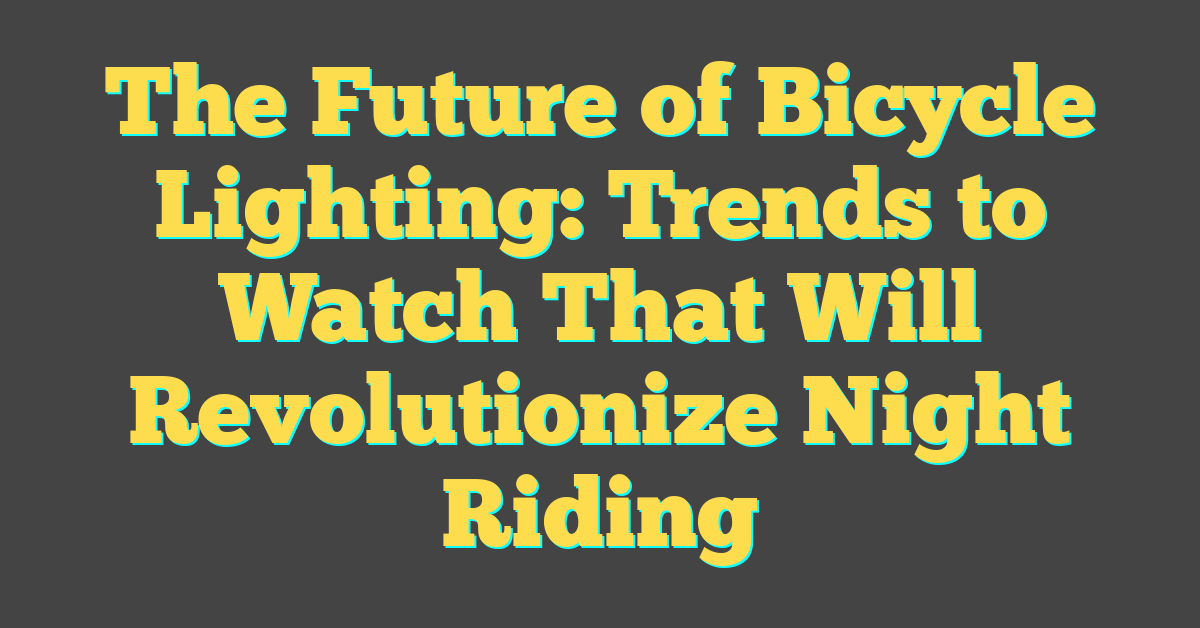Riding a bike at night has always had its challenges, but advancements in bicycle lighting are making those evening rides safer and more enjoyable. I’ve noticed how technology is transforming even the smallest details, and bike lights are no exception. From smarter designs to eco-friendly innovations, the future of bicycle lighting is brighter than ever—literally.

What excites me most is how these trends are shaping the way we think about safety and convenience. Whether it’s lights that automatically adjust to your surroundings or systems powered by renewable energy, there’s so much happening in this space. It’s not just about seeing and being seen anymore; it’s about creating a seamless, smarter biking experience.
The Evolution Of Bicycle Lighting
Bicycle lighting has come a long way from the simple reflector strips and battery-operated lights I remember installing on my first bike. Early systems relied on incandescent bulbs, offering limited brightness and short battery life. While they served their purpose back then, nighttime rides often felt risky and restrictive.
The introduction of LED technology revolutionized bike lighting. LEDs offered better brightness, lower energy consumption, and far greater longevity. I immediately noticed the difference on my rides at dusk; the visibility was sharper, and my batteries lasted much longer. Brands quickly adopted LED lights, incorporating features like waterproof casings and adjustable beam angles.
Dynamo systems brought a sustainable edge to lighting. These generate electricity from pedaling, eliminating the need for disposable batteries. I fitted one on my commuting bike, and not only did it reduce waste, but it also ensured my lights were always powered—even after my longest rides.
Smart lighting technology marks the latest breakthrough. Modern lights now adapt to surroundings, increasing brightness in low-visibility areas or dimming in well-lit zones. I recently tested a light with ambient sensors, and it completely transformed my nighttime cycling. Pairing these systems with smartphone apps allows for customization, like setting light modes or monitoring battery levels.
The shift toward integrated lighting has also enhanced bike aesthetics. Many high-end models now incorporate lights directly into frames or handlebars, creating a sleeker look. A bike I worked on recently had an integrated LED tail light, which aligned perfectly with its minimalist design, while still offering high visibility on the road.
Eco-friendly advancements continue to change the game. Solar-powered lighting options are gaining traction, with panels mounted on frames or helmets. One of my projects involved outfitting a solar light system, and seeing it charge during daylight rides always felt satisfying.
From basic bulbs to intelligent, sustainable systems, bicycle lighting has adapted to meet the needs of modern cyclists. Each new development makes me even more excited about what the future holds for night riding technology.
Key Innovations Shaping The Future
Bicycle lighting is entering an exciting era of technological advancement. I’ve been closely watching the trends, and it’s clear that innovation is pushing both performance and sustainability to impressive new levels.
LED Technology Advancements
LED technology is transforming bicycle lighting. Today’s LEDs provide enhanced brightness with minimal energy consumption, making rides safer even on the darkest roads. Models offering adjustable beam patterns allow precise control over illumination, reducing glare for oncoming traffic. Some LEDs now include adaptive brightness, automatically adjusting output based on surroundings. With compact designs and extended lifespans—often surpassing 50,000 hours—LEDs ensure maximum efficiency and durability.
Integration With Smart Devices
Smart devices and bike lighting are a natural pairing. Many modern lights now sync with apps, enabling features like remote brightness control, battery monitoring, and GPS integration. Some systems respond to real-time data, such as slowing brightness during stops or flashing for navigation alerts from your phone. These connected systems not only enhance safety but also simplify customization, letting riders optimize functions for their unique preferences.
Solar-Powered Lighting Systems
Solar-powered systems are redefining eco-conscious lighting. These setups combine solar panels with rechargeable batteries, creating lights that self-sustain even on long trips. With advancements in photovoltaic technology, modern panels work efficiently in partial sunlight, ensuring consistent performance. I’ve noticed that riders seeking sustainable options are drawn to these lights, as they align well with reducing environmental impact without sacrificing convenience.
Trends To Watch In Bicycle Lighting
Bicycle lighting is advancing rapidly, offering safer, more efficient, and eco-conscious solutions for cyclists. I’m always excited to explore the new trends shaping this space as both a bike enthusiast and a lighting expert.
Adaptive Lighting For Enhanced Safety
Adaptive lighting optimizes visibility by adjusting brightness based on speed and surroundings. Faster speeds prompt lights to intensify, providing clearer road visibility, while slower speeds reduce glare for pedestrians. Some systems automatically detect oncoming vehicles, dimming lights to avoid blinding drivers. For example, models like Garmin’s Varia utilize integrated sensors to adjust beam intensities in real time. These intelligent features significantly enhance safety during low-visibility rides.
Minimalist And Aerodynamic Designs
Sustainability in Cycling: Eco-Friendly Lighting Options That Every Cyclist Should Know About »
Lighting systems are embracing sleek, aerodynamic profiles that complement modern bike designs. Compact lights, often integrated into handlebars or frames, maintain aesthetic appeal and reduce drag. For instance, integrated stem lights combine functionality with minimal design, offering streamlined solutions for competitive riders. Wireless designs further eliminate clutter, giving bikes a clean, polished look that I personally find inspiring when upgrading my own gear.
Focus On Sustainability And Eco-Friendly Solutions
Eco-friendly lighting solutions are attracting growing attention, with solar-powered systems leading the charge. I’ve seen advancements in rechargeable batteries that last longer and reduce waste. Brands are using recyclable materials for casing and components, aligning with sustainable practices. Lighting systems powered by renewable energy, like pedal-generated dynamos, are not only efficient but also offer hassle-free operation, especially for long-distance riders seeking reliable lighting with low environmental impact.
Challenges And Opportunities In Bicycle Lighting
Innovation in bicycle lighting brings both hurdles and potential. Addressing these challenges opens doors to better designs, enhanced safety, and wider adoption.
Overcoming Cost Barriers
Cost remains a significant challenge in advanced bicycle lighting systems. High-performance features like adaptive lighting, solar power integration, and smart connectivity often lead to higher price points, limiting accessibility for many riders. As I’ve seen in my own experiences building and customizing bike setups, balancing quality with affordability requires thoughtful manufacturing solutions. By optimizing production processes and utilizing scalable materials like modular LEDs, manufacturers can reduce costs without sacrificing performance. Retail initiatives like bundling lighting with bike purchases or offering upgrade incentives can also make innovations more attainable.
Balancing Design And Functionality
Merging aesthetics with practicality is crucial for modern cyclists. While minimalist designs enhance bike frames and reduce drag, they sometimes compromise on aspects like light output or durability. I’ve experimented with integrating lights into bike builds and know firsthand the challenges of ensuring both form and function. Effective designs should incorporate sleek profiles alongside robust performance. For example, adjustable mounts or hidden wiring systems can maintain a clean look while delivering reliable functionality. Striking this balance helps cater to both performance-driven riders and those focused on style.
Conclusion
The future of bicycle lighting is brighter than ever, with innovations that blend safety, style, and sustainability. I’m excited to see how these advancements will continue to transform the riding experience, making it smarter and more eco-friendly.
As technology evolves, it’s clear that cycling at night will become not just safer but also more enjoyable. Whether it’s adaptive lighting, sleek designs, or renewable energy solutions, the possibilities are endless. I can’t wait to see what’s next for cyclists everywhere.




